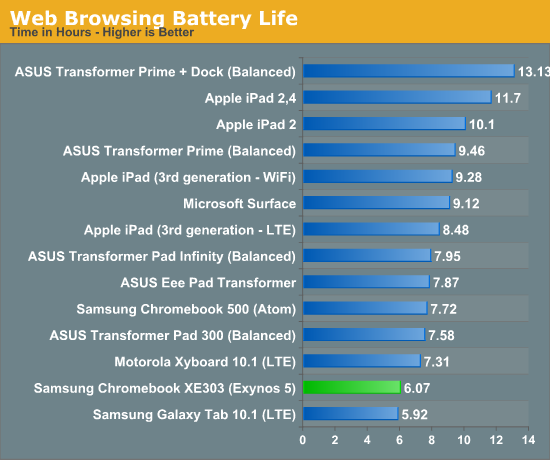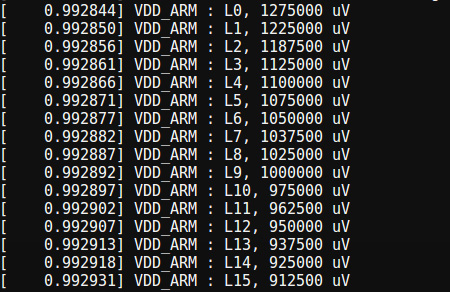Samsung Chromebook (XE303) Review: Testing ARM's Cortex A15
by Anand Lal Shimpi on October 31, 2012 9:00 AM ESTBattery Life & Power Analysis
The final unknown in all of this is power consumption. ARM's Cortex A15 isn't really supposed to be a sipper of power, and when placed in a notebook I don't know that there's a lot we can conclude about how it stacks up to Atom either. Some high level power consumption data would normally help but these two platforms are fairly different:
| Samsung Chromebook Power Consumption Comparison | ||||||
| Display @ 200 nits | Idle | Kraken (Avg) | Kraken (Peak) | |||
| Samsung Chromebook 500 (Atom N570) | 11.53W | 14.4W | 15.2W | |||
| Samsung Chromebook 303 (Exynos 5 Dual) | 6.33W | 10.5W | 11.3W | |||
The new Chromebook consumes considerably less power at idle than its predecessor. The smaller display, simplified motherboard and truly integrated SoC platform are likely all to thank for this. The significant reduction in power also helps explain the big reduction in battery capacity as well.
Under load, the two platforms do see differing levels of additional power consumption. The new Exynos 5 based Chromebook sees a dramatic increase in power consumption under load, hitting 10.5W (a 66% increase over idle) while running Mozilla's Kraken benchmark. The Atom N570 based Chromebook increases power consumption as well, but just not by as significant a degree: ~25%. This actually helps illustrate exactly why Atom wasn't phone worthy in its earlier incarnations. Contrary to popular belief, it wasn't actually peak power consumption that was the problem (a move to 32nm can easily eat into these numbers). The total platform power consumption, particularly at idle, was Atom's real problem in the early days. It also turns out that this is much of what keeps Intel's Core processors from moving into ultra mobile form factors, something that Haswell is supposed to address.
Given that we're dealing with somewhat different panels here, I wanted to see what power consumption looked like if we removed the panels from the equations. I re-ran all of the power data with the display turned off:
| Samsung Chromebook Power Consumption Comparison | ||||||
| Display Off | Idle | Kraken (Avg) | Kraken (Peak) | |||
| Samsung Chromebook 500 (Atom N570) | 8.82W | 11.4W | 12.4W | |||
| Samsung Chromebook 303 (Exynos 5 Dual) | 4.07W | 8.32W | 9.27W | |||
The old Atom based Chromebook uses more than twice the idle power of the new version - it's no wonder Google was able to get away with a battery half the size. Once again however we see a much larger increase in power consumption once the Cortex A15 is under heavy load. Active power consumption more than doubles on the new Chromebook, while we see around a 30% increase on the Atom based system. I do wonder what will have to be done to get the Exynos 5 Dual into a smartphone as an increase of ~4W under load just won't cut it in a phone. The Atom platform shows a 2.6W increase in power under load, which sounds about right for a high clocked 45nm part.

Despite the more power efficient platform, the reduction in battery capacity puts the new Chromebook well below the Atom model in battery life. Our wireless web browsing test put the new Chromebook at just over 6 hours of continuous use on a single charge. For a notebook that's not too bad, but compared to modern tablets it's not good.

The performance gains over Atom (and by extension, the ARM Cortex A9) do give us some indication as to what could be done to get Exynos 5 into a smartphone. By dropping clocks much lower than 1.7GHz Samsung would be able to maintain a performance advantage in a very power constrained device and hopefully keep power in check. The photo above features a list of all of the voltage levels supported by Samsung's Exynos 5 Dual as implemented in the new Chromebook.










149 Comments
View All Comments
wumpus - Wednesday, October 31, 2012 - link
I would assume that the real issue is if you can wipe chromeOS and replace with the linux of your choice. By the security choices you list, I wouldn't be using any type of windows box. From the comments below, there doesn't appear to be a "plug a USB stick in and hit a button" linux disto yet.jeffkro - Wednesday, October 31, 2012 - link
Look into ixquick if you are worried about search privacy.jeffkro - Wednesday, October 31, 2012 - link
"I'm not sure, but I think there's no choice for editing text apart from Google Docs?"If you are really tied to MS office you can use MS's cloud based office suite.
jjj - Wednesday, October 31, 2012 - link
Nice perf numbers.On power consumption both the software and the hardware are a lot different form a phone so maybe it's not as bad as you think.Now all we need is quad A15 :D (might be doable in tablets/notebooks with bigLITTLE or Nvidia's 4+1 even on 28nm)
Roland00Address - Wednesday, October 31, 2012 - link
It will be 4 A15 cores plus a low power companion core. Who knows when it will be actually in devices.I have not heard any announcements for quad core A15 from other sources (such as Samsung) that said it is going to happen sometime even if it has not been announced.
Jorange - Wednesday, October 31, 2012 - link
Excellent I've been waiting for this review. Exynos 5250 does seem a power hungry chap, which kinda destroys my hopes for a quad-core 5450 / Mali T658 in the next Galaxy phone, unless Samsung move to a new node. There is mention of 28nm process on Samsung's foundry site, combined with Big.little maybe my dreams are alive.Anand, any news when Samsung will adopt a new process node, and will it be 28nm or 22nm?
Work is already underway to port Ubuntu to it:)
http://www.omgubuntu.co.uk/2012/10/ubuntu-12-04-up...
amdwilliam1985 - Wednesday, October 31, 2012 - link
I share your excitement, I have SGS3 and I'm so looking forward to SGS4 and what it can bring to the table. Hopefully some sort of big.LITTLE design to lower the power draw, also there is a trend of bigger battery, hopefully the trend continues without much increasing in the physical size.Krysto - Thursday, November 1, 2012 - link
Why? Samsung will do it just like Nvidia with Tegra 4, and put 1 or 2 Cortex A7 chips next to the A15's, which will handle 80% of the tasks.Aenean144 - Thursday, November 1, 2012 - link
I'm curious how big.LITTLE is going to work in practice. The auto switching between discrete graphics and integrated graphics on laptops may give us a clue on how well it works.Hitting 9 W peak at 1.7 GHz? That's Haswell territory, and I'd surmise Haswell will crush any ARM, even the 64 bit ones in 2014, with a 10 W TDP envelope.
Secondarily, either Samsung is binning some low power parts for the Nexus 10 and prospective smartphones, or they have to downclock. The big question would be how much would they have to downclock.
On to the Nexus 10 analysis.
Kevin G - Wednesday, October 31, 2012 - link
Very respectable performance from the Cortex A15. It'll be interesting to see how it'll fair in a smart phone but the bar has been set.